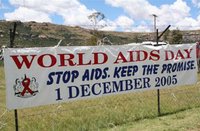[ . BACK to Worldkigo TOP . ]
:::::::::::::::::::::::::::::::::::::::::::::::::::::::::::::::::::::::::::::::::::::::::::::::::::::
Umbrella (mwavuli -- Swahili)
***** Location: Kenya, tropics
***** Season: Short rains, long rains
***** Category: Humanity
*****************************
Explanation
When either of the two annual rainy seasons hit Kenya, umbrellas appear throughout the country -- in people's hands, in shops and street stalls, and in buildings and vehicles.
Most often, rain strikes mid-afternoon as a tropical downpour, and it is best to be prepared. Strong winds are not a feature of the Kenyan weather -- so, umbrellas are popular and many even opt for the large Chinese golf umbrella -- heavy but providing excellent shelter.
 http://en.wikipedia.org/wiki/Image:Umbrella.jpg
http://en.wikipedia.org/wiki/Image:Umbrella.jpg
Every day is a test of one's weather forecasting skills -- to take the heavy umbrella and have to lug it even if it does not rain, or to leave it at home and expose oneself to the risk of being drenched to the skin.
Mind you, even with an umbrella that often happens, as the rain gathers in torrents on streets, the heavy raindrops splash up and the passing cars wash up major waves, bus queues wind round entire blocks, vehicles splutter and collapse, and traffic jams engulf the city as roads turn into rivers and become impassable.
Rivers may leave their courses and wash away roads, bridges and fields. Waves run down inclines, and slum dwellers can find rain water running right through their homes. Many have to use stepping stones within their houses for several weeks as the rains return every day. Mosquitos hatch and appear, and with them bouts of malaria.
But when there is no rain, crops do not grow and the country suffers from malnutrition and famine... When it does not rain, the poor suffer, and when it rains, the poor suffer...
Isabelle Prondzynski
:::::::::::::::::::::::::::::::::::::::::::::::::::::::::::::::::::::::::::::::::::::::::::::::::::::
Umbrella
An umbrella is a device used for temporary shade or shelter from precipitation. They can be made by stretching a fabric or other material over a wire frame. Umbrellas carried by hand are now usually used as rain shields, although their first use was for shielding from the sun; however, as tans became more sociably acceptable, this usage declined.
An umbrella made for protection from the sun, is called a parasol. These are often meant to be fixed to one point and often used with patio tables or other outdoor furniture, or on the beach for shelter from the sun.
The word "umbrella" is from the Latin word "umbra" for shade or shadow.
History
Depictions on ancient artifacts provide evidence that umbrellas have been in existence for over four thousand years. The civilizations of ancient Assyria, Egypt, Greece, and China all used umbrellas. It was not until the 16th century that the trend spread to Europe.
In
England, umbrellas were only used by women until the practice was popularised by Jonas Hanway (1712-86). Having noted the custom in Portugal, in the 1750s he started to carry an umbrella regularly in London, and continued to do so for thirty years despite derision. Another pioneering Londoner was John MacDonald, who from 1778 used a silk umbrella when it rained. The use of "Hanways" by English gentlemen slowly spread, so that by 1790, their pioneering efforts had helped lift the English taboo against men carrying umbrellas.
Chinese umbrellas have traditionally been made of either
oilpaper, or silk on a bamboo frame. Victorian era umbrellas had frames of wood or baleen, but these devices were expensive and hard to fold when wet. Samuel Fox invented the steel-ribbed umbrella in 1852. Modern designs usually employ a telescoping steel trunk. New materials such as cotton, plastic film and nylon often replace the original silk. They now are available in compact collapsible designs.
http://en.wikipedia.org/wiki/Umbrella
xxxxxxxxxxxxxxxxxxxxxxxxxxxxx
Full text of Umbrellas and their History by William Sangster, from Project Gutenberg.
http://www.gutenberg.net/etext/6674

*****************************
Worldwide Use
Japan

The umbrella is used quite often, especially during the rainy season. But in haiku, it is used as a
nonseasonal topic.
Page full of Oilpaper Umbrellas (kasa 傘). The most famous one is the "Umbrella with the eye of a snake
ja no me gasa 蛇の目傘), which also is often used in Kabuki plays.
 Look at some great collections of these umbrellas:
Look at some great collections of these umbrellas:
http://www.gendaiya.co.jp/s_wagasa.htm
http://www.joaf.co.jp/kasa-umblera/kasa-menu-index-.htm
. Janomegasa 蛇の目の傘 Edo-umbrella .
and the manners of Edo (Edo shigusa 江戸しぐさ)
. tooyugami 桐油紙 oil paper with paulownia oil .
and the oil-paper raincoat
Kappa 合羽
bangasa 番傘 Bangasa, "numbered umbrella"
a coarse oil-paper umbrella
 - quote -
- quote -
Bangasa is a common type among Japanese umbrella. It gives beefy and durable impression.
Because of that, this umbrella for the masses goes well with male putting on kimono.
The reason called "Ban-gasa" is said as follows. Umbrella craftsman was stamped (BAN) to self-made umbrella.
Another reason is that umbrella to lend at inn was numbered (BAN).
In Osaka,
to distinguish between the master-servant relationship, Bangasa for attendant was edged in black.
In Kyoto,
umbrella for accompany is three lines pattern when closed as everyone can see at a glance who accompany court noble.
In both cases,
the master was an umbrella of golden brown or dark brown and thicker than Janomegasa.
-
Ruson Sukezaemon 呂宋助左衛門 imported umbrellas and pottery from Luzon, Philippines in Azuchi-Momoyama period (1558-1600 CE).
That's why it was widely spread in Edo period (1603-1868 CE).
- MORE about the history of Umbrellas in Japan:
- source : terimakasih.cc/gallery/umbrella-
- - - - -Once upon a time in Osaka
on a rainy day an actor was walking along with his Bangasa. The umbrella suddenly felt very heavy and then very light. The man made a summersault, threw the umbrella on the road and fled in great haste.
Next morning, what do you say ! there was a dead Tanuki badger on the road.
 source : aimatarou.blog63.fc2.com...
kasa-sashi tanuki 傘さし狸 Tanuki with Umbrella
source : aimatarou.blog63.fc2.com...
kasa-sashi tanuki 傘さし狸 Tanuki with Umbrella
A Yokai from Tokushima / 徳島県三好郡池田町
During times like rainy evenings, it would disguise as a person with an umbrella and invite people. When a person who doesn't have an umbrella goes under it, it is said that they'd be taken to unbelievably out-there place.
- quote wikipedia Japanese raccoon dog -
...........................................
In Japan, farmers and travellers in olden times used a large straw hat as umbrella, sometimes translated as
umbrella-hat (kasa, 笠).
. - umbrella hat (kasa 笠) - .
kigo for all summer
.................................................................................
kigo for all summer
higasa 日傘 (ひがさ) parasol
ehigasa e higasa 絵日傘(えひがさ)
parasol with a pattern
parasoru パラソル Parasol, Sonnenschirm
natsu koomorigasa 夏洋傘(なつこうもりがさ)
European-style umbrella for summer
(lit. 蝙蝠傘 "bat umbrella")
Knirps
 傘に押し分けみたる柳かな
傘に押し分けみたる柳かな
karakasa ni oshiwake mitaru yanagi kana
with my umbrella
I part the branches
of the willow trees . . .
Written in the spring of 1694 元禄7年 as the hokku for a haikai meeting with Jokushi 濁子, Yaba 野坡 and others. Basho describes his experience on the way to the meeting.
The cut marker KANA is at the end of line 3.
 . Matsuo Basho 松尾芭蕉 - Archives of the WKD .
. Matsuo Basho 松尾芭蕉 - Archives of the WKD .
Nakagawa Jokushi 中川 濁子 / 蜀子
. Nozarashi Kiko 野ざらし紀行 .
.................................................................................
青山を始て見たる日傘哉
aoyama o hajimete mitaru higasa kana
seeing the green mountain
for the first time ...
ladies with parasols
Tr. David Lanoue
parasols see
fresh green mountains
for the first time
Tr. Chris Drake
This hokku was written on 4/12 or June 1 in 1803, when Issa was in Edo.
. - READ the comment by Chris Drake - .
傘の雫ながらにかすみかな
karakasa no shizuku-nagara ni kasumi kana
in the mist
spring drips from
my umbrella
Tr. Chris Drake
This hokku was written at the end of the 1st month (late February) in 1822, during early lunar spring, and mist has begun to replace the snow. The mist is so thick and wet you need to use an umbrella, and Issa seems fascinated by the way his umbrella causes the shapeless mist to take on shape -- to appear as water drops that drip from the edges of his umbrella. Spring begins to take on definite form and is surely here to stay, even in the Shinano mountains.
Issa doesn't record any rain for the 1st month. He mentions snow several times, so it's possible to interpret the umbrellas as being used for the snow, though I feel that if it were snowing, Issa would have mentioned it.
Chris Drake
. WKD : Kobayashi Issa 小林一茶 in Edo .
.................................................................................
rushing past
in the shadow of dunes
parasols in a row
Vidur Jyoti, India
.................................................................................
. terifuri-gasa 照り降り傘
umbrella for rain and shine .
:::::::::::::::::::::::::::::::::::::::::::::::::::::::::::::::::::::::::::::::::::::::::::::::::::::
India
During the monsoon, the umbrella is a daily companion.
My impression of Bombay:
monsoon shower –
holding on to
black umbrellas
Gabi Greve
World Kigo Database: Monsoon
:::::::::::::::::::::::::::::::::::::::::::::::::::::::::::::::::::::::::::::::::::::::::::::::::::::
In both
Ireland and
Belgium, umbrellas are not kigo, as it can rain all year round. In Ireland, they are not even much used, as winds are inclined to carry them off!
:::::::::::::::::::::::::::::::::::::::::::::::::::::::::::::::::::::::::::::::::::::::::::::::::::::::
Things found on the way
Umbrellas in the Edo Period
 furugasa kai 古傘買い buying old umbrellas in Edo
furugasa kai 古傘買い buying old umbrellas in Edo
kasa no furobone kai 傘の古骨買い
buying old umbrella frames
They payed anything from 4 mon to 20 mon for an old umbrella and bring them to a dealer in old umprellas 古傘の問屋. They were taken apart, the oil paper and very rotten bamboo frames could be used instead of firewood. Other people would take the frame for rapair work, especially putting new paper on the frame (傘張り kasa hari). Masterless ronin samurai often did the papering as a kind of side business.
The buyers of old frames used to call out:
furubone ba gozai furbone ba gozai
 - quote
Recycling in Edo
- quote
Recycling in Edo
It was usual in the past, in fact, to repair anything, and not just expensive items like paulownia chests.
Umbrellas, for example, would be repeatedly repaired. In an age when experienced carpenters earned a daily wage of 500-600 mon, umbrellas cost 200-300 mon, which means that while they were not particularly expensive items, they were nevertheless not the kind of thing one would throw away without a care.
They were made of bamboo and paper, which means that no matter how sturdily made they were, their life spans were limited, particularly in view of the fact that they were repeatedly exposed to rain. The paper used was sturdy Japanese paper treated with persimmon tannin and wood oil, but even so, as it aged, it would become increasingly brittle and prone to tearing.
- source : www.japanfs.org - Ishikawa Eisuke
furubone kai 古骨買い buying old parasols and umbrellas (the "bones")
. Recycling and Reuse in Edo - リサイクル と 再生 / 再使用 .
古傘にいつも越後が二、三本
furugasa ni itsumo Echigo ga ni-sanbon
well, old umbrellas
are always stocked at Echigoya store,
two or three of them

Echigoya had printed his shop crest on each umbrella and gave them to customers for cheap advertisement.
. Edo Echigoya 越後屋 and Mitsui 三井 .
四、五人に当たり古傘伊勢屋売り
shi-go nin ni atari furugasa Iseya uri
five or six persons work
at an old umbrella and then
Iseya sells them
. senryu, senryū 川柳 Senryu in Edo .
 CLICK for more photos !
CLICK for more photos !
- - - - - - - - - -
- Yosa Buson was very fond of umbrellas -
古傘の婆娑としぐるゝ月夜哉
古傘の婆裟と月夜のしぐれ哉
furugasa no basa to shigururu tsuki yo kana
old umbrella
glistening in a winter shower
tonight the moon wears a halo . . .
Tr. Cheryl A. Crowley
The cut marker KANA is at the end of line 3.
furugasa ni kufuu no tsukanu kagashi kana
this old umbrella
is not even suited for making
a scarecrow . . .
Tr. Gabi Greve
The cut marker KANA is at the end of line 3.
 source : blogs.yahoo.co.jp/shashunsei
しぐるゝや用意かしこき傘二本
. Yosa Buson 与謝蕪村 in Edo .
source : blogs.yahoo.co.jp/shashunsei
しぐるゝや用意かしこき傘二本
. Yosa Buson 与謝蕪村 in Edo .
- - - - - - - - - -
. Recycling and Reuse in Edo - 江戸の リサイクル .
. Edo craftsmen 江戸の職人 shokunin .
 source : gimp2-how-to-use.blogspot.jp ...
kasashi, kasa-shi 傘師 making umbrellas
source : gimp2-how-to-use.blogspot.jp ...
kasashi, kasa-shi 傘師 making umbrellas
 source : nwn.jp/old/kakokizi
source : nwn.jp/old/kakokizi
A scene from Edo Honcho (Motomachi) 本町九丁目 about 200 years ago.
There were about 20 shops making and selling umbrellas.
One type was matsubagasa (matsuba-gasa) 松葉傘,
the other Kishuugasa 紀州傘 Kishu-gasa.
The bamboo support was made in the back of the shop. There was a pot to keep the nori 糊 glue, which was applied with a special brush on the bamboo to secure the paper. In the front of the shop craftsmen were painting the umbrellas with oil 油引き, to make them water-proof. Others were adding the special top paper 頭紙.
The finished umbrellas were spread out on the roadside to dry.
kasa hari 傘張り gluing paper to umbrellas
was also a side business of poor Samurai.
 source : ameblo.jp/edo-sanpo
. kasa hari 傘張り gluing paper to umbrellas in Edo .
source : ameblo.jp/edo-sanpo
. kasa hari 傘張り gluing paper to umbrellas in Edo .
.......................................................................
. wagasa 和傘 Japanese paper umbrella .
Gifu wagasa 岐阜和傘
Kanazawa wagasa 金沢和傘 (Ishikawa)
Kyoowagasa 京和傘 Kyo-Wagasa (Kyoto)
Yodoegasa 淀江傘 (Tottori)
Kishu wagasa 紀州和傘 (Wakayama)
Yamagata wagasa 山形和傘
.......................................................................
. Join the Ukiyo-E friends on facebook ! .
 :::::::::::::::::::::::::::::::::::::::::::::::::::::::::::::::::::::::::::
:::::::::::::::::::::::::::::::::::::::::::::::::::::::::::::::::::::::::::
HAIKU
bus queue --
soaked in downpour from
a blue umbrella
 http://en.wikipedia.org/wiki/Image:Umbrella_with_raindrops.jpg
http://en.wikipedia.org/wiki/Image:Umbrella_with_raindrops.jpg
Isabelle Prondzynski
xxxxxxxxxxxxxxxxxxxxxxxxxxxxxxxxx
Rain streaks down eaves
Click of umbrella opening
http://awakening.to/rainy.html
xxxxxxxxxxxxxxxxxxxxxxxxxxxxx
he loved the rain
she came into his life
and gave him an umbrella
Alexey V. Andreyev
http://haiku.cc.ehime-u.ac.jp/~shiki/shiki.archive/html/9512/0273.html
.. .. ..
a star
in a tear -
my old umbrella
裂け目にポツン
星ひとつ
ぼくの 古傘
Alexey V. Andreyev
http://www.happano.org/pages/moyayama/newhaiku.html
xxxxxxxxxxxxxxxxxxxxxxxxxxxxxxxxxxxxxxxxxxxx
.. .. .. From Zhanna P. Rader
Raining cats and dogs.
under his umbrella
my loony uncle jogs
(New Cicada, vol. 7, #1, Summer 1990)
Spring rain --
grandma plops in a puddle -still holds
the umbrella over her head
(unpublished)
August rain -
we step out hand in hand
without umbrellas
(WHR, Oct. 2003)
*****************************
Related words
***** Parasol (higasa 日傘):
kigo for all summer in Japan, hot dry season in Kenya.
Beautiful red oil parasols are used during theTea ceremony outside (noten gasa 野点傘).
 Look at some more umbrellas here:
http://www.rakuten.co.jp/kasaya/403035/475062/#427193
haru no kasa 春日傘 (はるひがさ) parasol for spring
Look at some more umbrellas here:
http://www.rakuten.co.jp/kasaya/403035/475062/#427193
haru no kasa 春日傘 (はるひがさ) parasol for spring
......................................................................
cherry blossom party -
the red umbrella
invites to tea
 Look at the picture and more haiku by Gabi Greve here:
http://happyhaiku.blogspot.com/2005/03/cherry-blossoms-sakura.html
Look at the picture and more haiku by Gabi Greve here:
http://happyhaiku.blogspot.com/2005/03/cherry-blossoms-sakura.html
xxxxxxxxxxxxxxxxxxxxxxxxxxxxxx
Look at the
.. .. .. .. Rain in various KIGO (Japan)
:::::::::::::::::::::::::::::::::::::::::::::::::::::::::::::::::::::::::::::::::::::::::::::::::::::
***** stepping stones
kigo for the short rains, long rains
Stepping stones, step-stone bridge
:::::::::::::::::::::::::::::::::::::::::::::::::::::::::::::::::::::::::::::::::::::::::::::::::::::

:::::::::::::::::::::::::::::::::::::::::::::::::::::::::::::::::::::::::::::::::::::::::::::::::::::
[ . BACK to DARUMA MUSEUM TOP . ]
[ . BACK to WORLDKIGO . TOP . ]
- #umbrella #kasa -
:::::::::::::::::::::::::::::::::::::::::::::::::::::::::::::::::::::::::::::::::::::::::::::::::::::








































